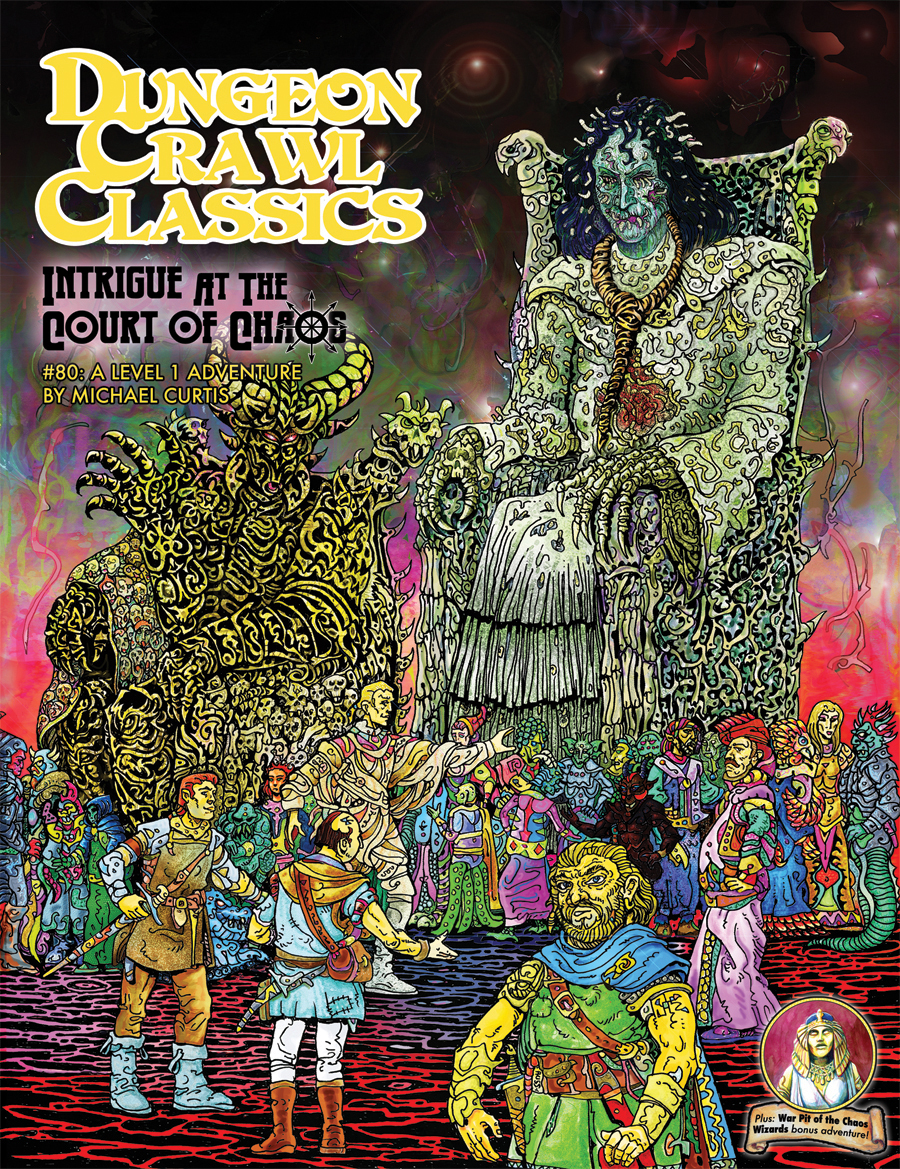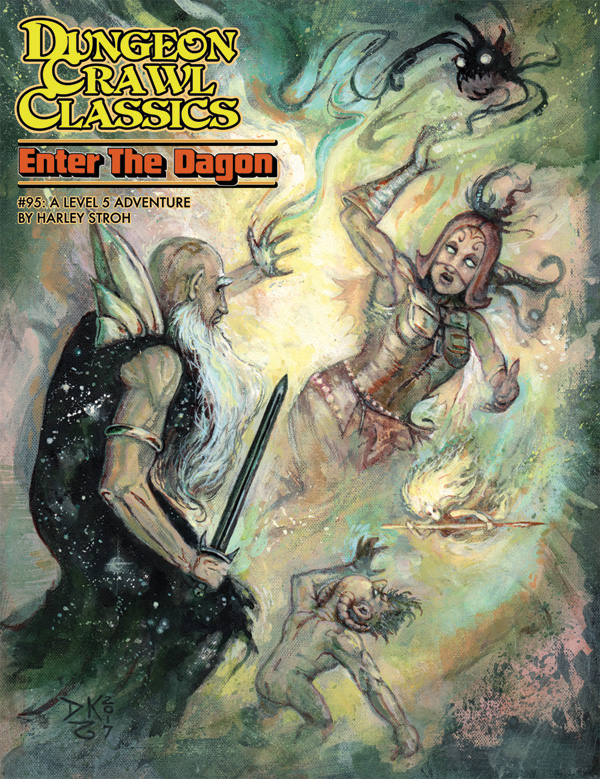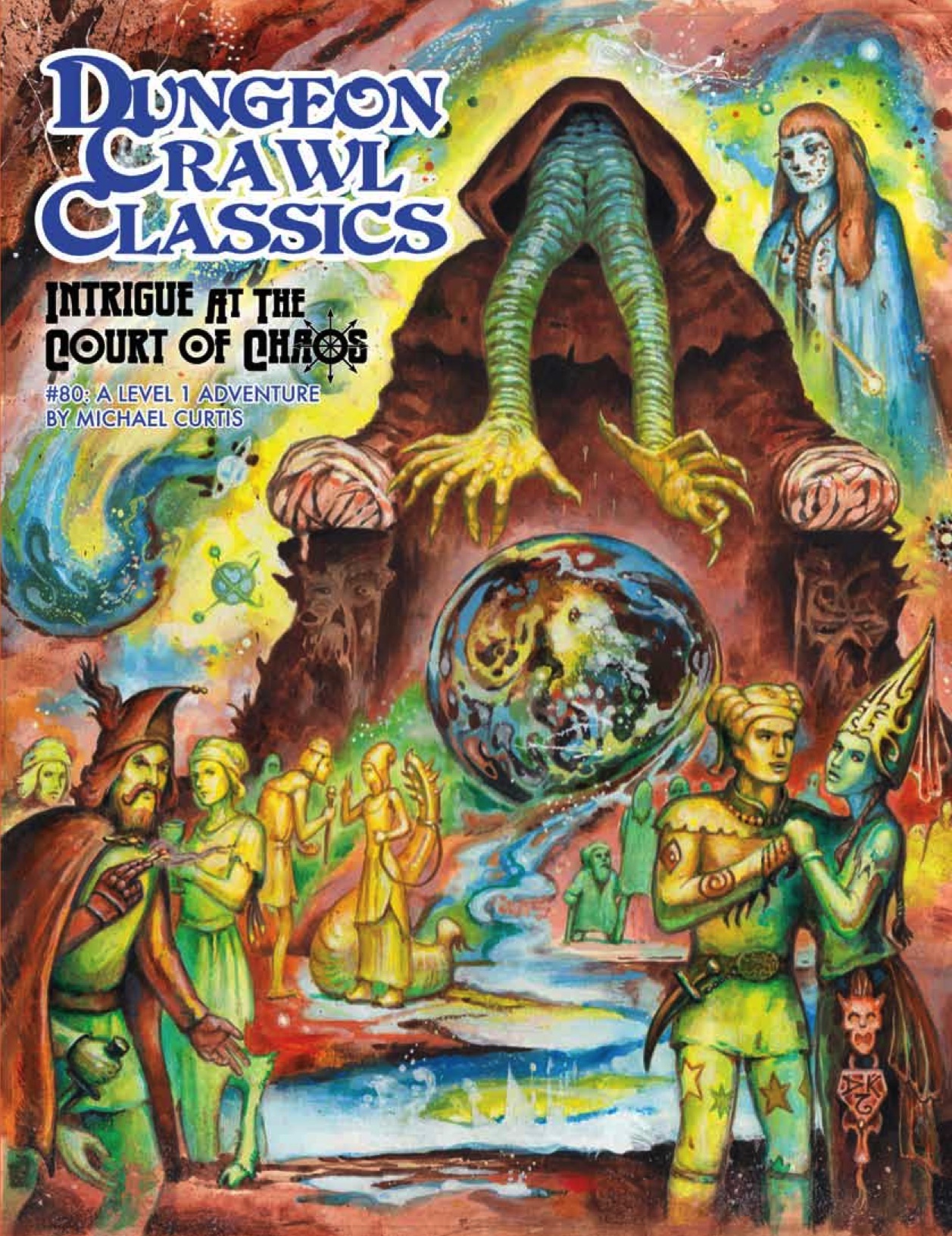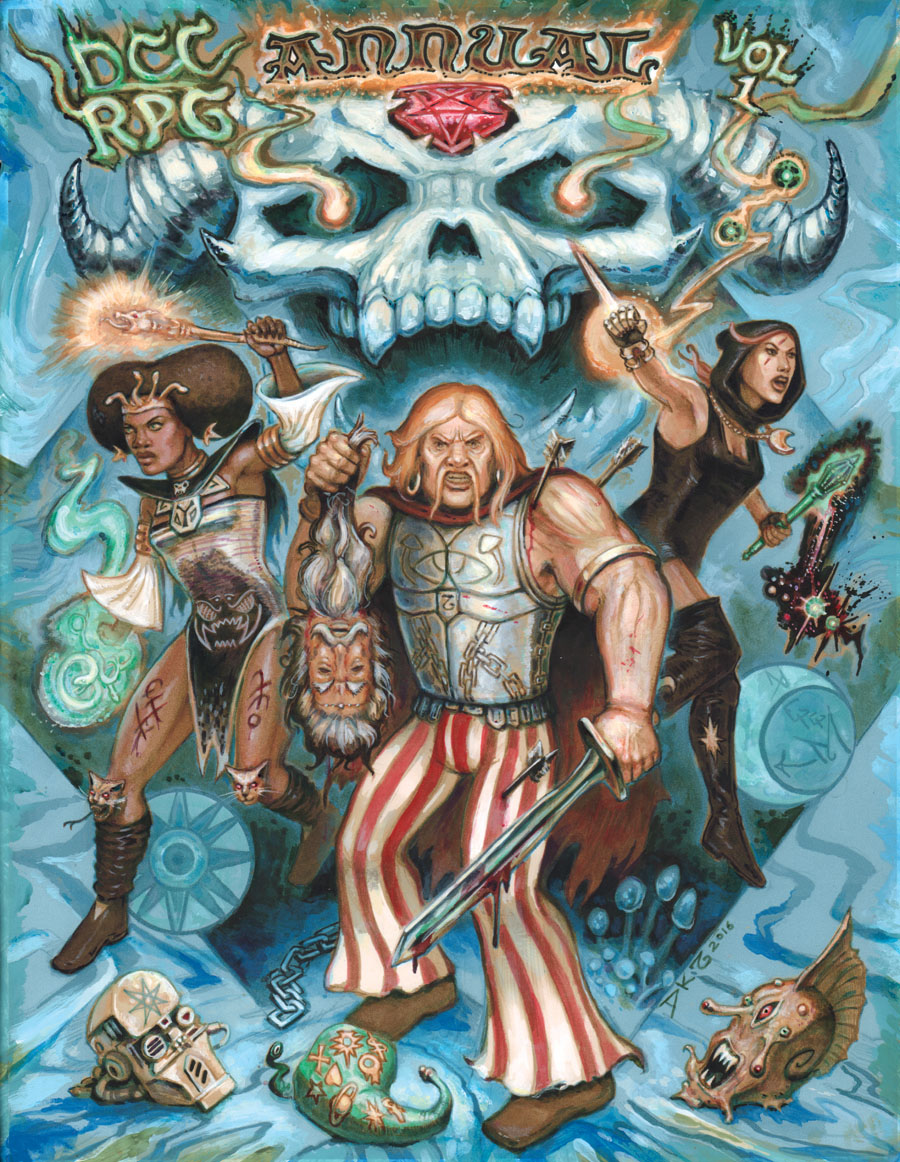RPG Guide: Dungeon Crawl Classics (DCC) RPG
The DCC Roleplaying Game is an homage to the kind of adventuring that was en vogue during the days when D&D was first published. More Conan the Barbarian than J.R.R. Tolkien, DCC uses pulp fantasy tropes, a fair amount of randomness, and a lot of gonzo ideas to reimagine 70s D&D through a  modern lens. If you’re looking for a game that emphasizes fun and randomness over careful narrative and tightly balanced rules, DCC-RPG might be for you. The game is supported by over 100 well-written adventures. It isn’t afraid to mix in a little sci-fi with its fantasy, and its published settings include adaptations of some of D&D’s biggest original influences.
modern lens. If you’re looking for a game that emphasizes fun and randomness over careful narrative and tightly balanced rules, DCC-RPG might be for you. The game is supported by over 100 well-written adventures. It isn’t afraid to mix in a little sci-fi with its fantasy, and its published settings include adaptations of some of D&D’s biggest original influences.
Straight Out of 1974
The Dungeon Crawl Classics RPG, in a lot of ways, is the answer to an intriguing question: what if you could go back to 1974 and create a version of D&D that more accurately captured the literary and pop-culture influences that inspired the original game? Modern fantasy games benefit from almost 50 years of game design. In a lot of ways, the rules that power D&D have improved upon the model that Gary Gygax and Dave Arneson cobbled together back in the 70s. As it’s become streamlined, however, modern D&D has lost a lot of the flavor of the original game. The DCC RPG aims to reinject that flavor while using a more current framework of rules.
The Literary Roots of D&D
Most people can easily cite the obvious influence J.R.R. Tolkien’s Lord of the Rings novels had on D&D. The dwarves, elves, and hobbits…sorry, halflings, that have been a part of the game since its earliest days are straight from Tolkien. What might be less obvious are the influences of authors like Fritz Leiber, Robert E. Howard, and Jack Vance. But those authors are arguably far stronger than the Lord of the Rings, especially in the D&D of the 70s and early 80s.
There are D&D tropes that don’t fit in Tolkien at all. Morally grey adventurers who raid tombs and battle monsters for fame and riches? Powerful but dangerous magic that corrupts those foolish enough to wield it? Capricious demons, gods, and even stranger entities willing to bestow mystical favors in exchange for the loyalty of mortal followers? None of that really fits in Middle Earth. But it’s right out of the pages of Conan, Fafhrd and the Gray Mouser, and the Dying Earth. DCC takes those influences and turns them up to 11.
Come for the Adventures…
Before I dive deeper into the DCC RPG, let’s talk a bit about how this game came to be. Dungeon Crawl Classics began as a line of adventures written by Goodman Games for (then current) 3 / 3.5 edition of Dungeons & Dragons. Every one of those DCC adventures begins with the following quote:
“Remember the golden days of role playing, when adventures were underground, NPCs were there to be killed, and the finale of every dungeon was the dragon on the 20th level?”
on the 20th level?”
The quote may be a bit misleading. Most DCC adventure modules aren’t actually the trap-filled hack fests that the words “Dungeon Crawl” might imply. Still, I think that quote does capture the spirit of the sorts of modules Goodman games produces. Using the themes of old-school gaming, DCC publishes modules that emphasize fun at the table over elements like elaborate backstory or epic plots. The best of these pack a lot of really innovative content into a short, softcover book.
Adventure paths and big 5E modules can be a lot of fun, but it can also require a big commitment in order to complete them. Plus, they often require a lot of work on the part of the DM to set up and properly run. Dungeon Crawl Classics give enough story and flavor text to help the GM understand the module, and then focus on the hard parts: cool set pieces, interesting encounters, and clever puzzles and traps.
Even if you’re not ready to plunge into the DCC RPG itself, many of the modules are worth picking up and adapting to your preferred version of D&D. Goodman Games also publishes 5E modules, plus an absolutely wonderful line of classic D&D adventures updated to use the 5E rules.
For a listing of some of the best DCC RPG Modules, see My Favorite DCC Modules at the end of this article.
…But Stay for the System
Around the time that 4E D&D came out, Goodman Games decided to publish their own house system in order to support their adventures. The DCC RPG is inspired heavily by 1970s D&D, but its engine is built on something closer to Third Edition D&D. Characters have three saving throws, for example, called Fortitude, Reflex, and Willpower. Thieves (not rogues) possess abilities familiar to an old-school D&D player, with names like “Hide in shadows” and “Disable  Trap”. However, each of these skills is rolled with a d20 against a target number, very much like more modern versions of D&D.
Trap”. However, each of these skills is rolled with a d20 against a target number, very much like more modern versions of D&D.
The Funnel
Many people who are a little familiar with Dungeon Crawl Classics have heard of the Character Funnel. By default, you don’t start out playing DCC with a carefully crafted, level 1 character. Instead, you run a group of 4 or so utterly random level 0 nobodies. You might roll up a grave digger, a beekeeper, an elven glovemaker, and a gong farmer. Their stats are probably nothing to write home about, since you rolled them using the old “3d6 in order” method. Each character only has 1d4 hit points and is armed with whatever makeshift weapon they had laying around the farm.
Your job is to throw this reluctant band of peasants at a real, honest-to-goodness pulp D&D adventure and see who makes it to the other side. Faced with cultists, beast-men, and murderous traps, most of these characters will certainly die. The ones who survive, however, emerge as 1st-level DCC characters complete with a class and all the normal trappings of an adventurer.
The funnel is a surprisingly effective tool for starting a campaign. It sets the tone of a fantasy setting where death is very possible and challenges are not catered to the power level of the characters. For the GM, it gives a license to ignore game balance in favor of interesting locations and flavorful encounters. In standard D&D, no experienced DM would through low-level characters against an entire cult of Chaos-worshipping cultists. In DCC, that’s a standard level-0 funnel.
The Funnel works well from the player’s point-of-view as well. Yes, Funnel adventures can be unforgiving and dangerous. But you’re equipped with a whole mob of characters to throw at the problem. Despite the unfair odds, some of those level zero schmucks will certainly survive. And, the beautiful thing is, those who do survive won’t feel like schmucks any more. No longer is your goat farmer a simple goat farmer. Now they are the goat farmer who passed through a magical rift in the sky, helped fight a rat-demon, and lived to become a Warrior!
Beyond the Funnel
While the Funnel might be the most well-known part of the DCC game, it’s really just a character randomizer disguised as an introductory adventure. Dungeon Crawl Classics is a robust game fully capable of supporting long term play.
For one thing, the game beyond the Funnel isn’t nearly as deadly as one might think. While certainly less forgiving than, say D&D 5E, after level 0, a typical DCC character is actually fairly powerful. Characters can “burn” their Luck stat in order to improve the results of their dice rolls. They can freely attempt “mighty deeds” in order to execute special maneuvers during combat. And, just like the old school D&D that inspired it, DCC adventures try to reward clever, non-mechanical solutions to overcoming in-game obstacles.
deeds” in order to execute special maneuvers during combat. And, just like the old school D&D that inspired it, DCC adventures try to reward clever, non-mechanical solutions to overcoming in-game obstacles.
Funky Dice
Think back, for a moment, to the first time you encountered the unique dice used in D&D. There is something satisfying and highly tactile about rolling polyhedral dice. But there’s also something weird and almost mystical about them. As a new gamer, you couldn’t distinguish dice. With experience, you become a certified dice goblin, a rite of passage in RPGs.
The DCC RPG recreates the gaming experience with additional polyhedral dice in the core rules. Instead of just a d20 for attacks, players might roll a d16 and d14 when dual-wielding. Alongside the standard poly dice, DCC introduces seven more dice (d3, d5, d7, d14, d16, d24, and d30). These extra dice are used when bonuses or penalties affect dice rolls due to in-game circumstances, forming the “dice chain.” For instance, if a character gets purple slime in their eyes, they drop two steps on the dice chain and roll a d14 instead of a d20, avoiding a -6 penalty.
DCC doesn’t rely heavily on the funky dice. A GM could (mostly) ignore the dice chain in favor of penalties or bonuses. The rules pepper the funky dice in lots of innocuous places, such as random charts that offer d7 results instead of d8. So don’t think that you are absolutely required to buy new dice in order to play. But, if you do decide to go all in with the game, you’ll have some absolutely weird dice to add to your collection. Rediscover the awe you felt seeing a d12 or d4 for the first time.
Random Spells
 Perhaps the thing that makes the DCC RPG stand out from similar games is the way it handles spells. Rather than a set outcome for each spell, DCC presents each of its spells as a random chart. To determine how well the spell works, the wizard player rolls a d20 and adds their level (plus some other bonuses). Roll high enough and you’ll damage your foe with a couple of magical darts. Roll higher and you’ll get more missiles. Higher still, you might get a whole swarm of magic missiles. Other spells have even more variable results, and DCC sometimes manages to encapsulate two or three D&D spells under a single DCC spell.
Perhaps the thing that makes the DCC RPG stand out from similar games is the way it handles spells. Rather than a set outcome for each spell, DCC presents each of its spells as a random chart. To determine how well the spell works, the wizard player rolls a d20 and adds their level (plus some other bonuses). Roll high enough and you’ll damage your foe with a couple of magical darts. Roll higher and you’ll get more missiles. Higher still, you might get a whole swarm of magic missiles. Other spells have even more variable results, and DCC sometimes manages to encapsulate two or three D&D spells under a single DCC spell.
Players aren’t without agency in the face of all this randomness. Wizards can boost spells with Spellburn, sacrificing physical stats to enhance the roll. It’s a form of blood magic. Missed that spell roll by 5? Just burn 5 points of Strength and you’ll turn that failure into a success. But beware…too much Spellburn will leave your character fairly weak and helpless for the rest of the adventure.
Rolling poorly while spellcasting can have other consequences, beyond failure. Bad rolls lead to corruption, where spells’ magical energies harm the character physically. Spell corruption ranges from the inconvenient (you can no longer eat cooked food) to the Lovecraftian (now you have tentacles). Wizards can stave off the worst effects for a while, but meddling with too much magic is a dangerous pursuit.
Getting Started with DCC
All you really need to get started with DCC is the DCC RPG Rulebook. This book contains all the rules a player or GM will need to run the complete game. You’ll notice a lot of different printings of DCC, but don’t be alarmed. These aren’t different editions or rules sets. Goodman Games likes to print alternate covers, often featuring special guest artists. Go ahead and grab a used copy of an older printing from Noble Knight Games with no fear that you’re missing out on the latest version of the game.
on the latest version of the game.
Once you’ve run a Funnel or two, you’ll want your own set of funky DCC dice. If you’re looking to expand your DCC game, the DCC Annual is a fun book full of optional addons (and rules for super-cool magical mustaches).
of optional addons (and rules for super-cool magical mustaches).
My Favorite DCC Modules
As I mentioned above, the Dungeon Crawl Classics adventure line features some absolute gems. Here are links to my top d7 favorites, in no particular order and submitted with very little comment. Curious about DCC flavor? Try these before diving into the core rulebook!
Roll d7:
1. Sailors on the Starless Sea: My favorite “funnel” adventure and an absolute gem. If you’re looking for a good funnel, this is the one.
2. Chaos Rising: A collection of 7 short adventures. Great value and a sort of mini-campaign.
